Bennemann K.H., Ketterson J.B. Superconductivity: Volume 1: Conventional and Unconventional Superconductors; Volume 2: Novel Superconductors
Подождите немного. Документ загружается.

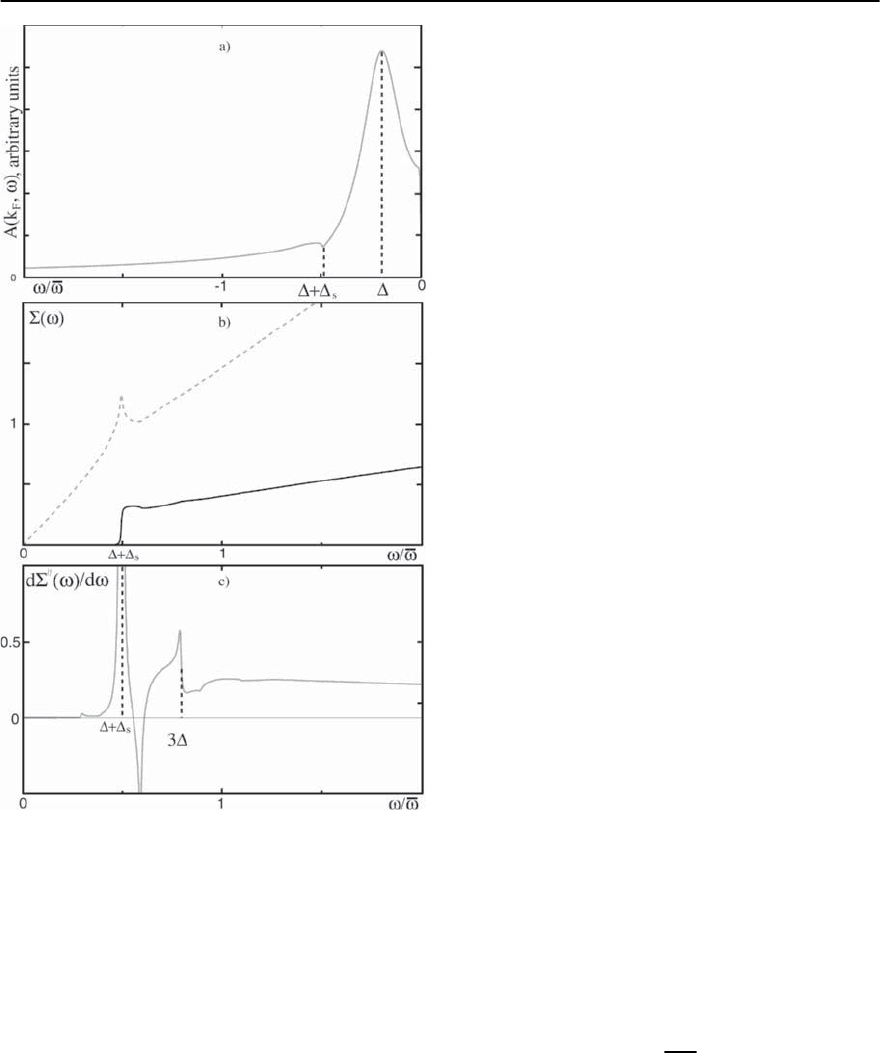
22 A Spin Fluctuation Model for d-Wave Superconductivity 1381
Fig. 22.17. Upper panel: the quasiparticle spectral function
determined by solving the coupled Eliashberg equations
for = 1. The peak-dip-hump structure of A(!) is clearly
visible but not dramatic. Middle panel: real and imagi-
nary parts of the fermionic self-energy (dashed and solid
lines, respectively). Lower panel: the frequency derivative
of £
(!). The extra structure at 3 is clearly visible. The
figure is taken from [133]
tion is consistent with our analytical estimate. We
clearly see that the fermionic spectral function has a
peak-dip-hump structure, and the peak-dip distance
equals
s
.We also see in Fig.22.17 that the fermionic
self-energy is non-analytic at ! =3.Aswedis-
cussed above, this last non-analyticity originates in
the non-analyticity of the dynamical spin suscepti-
bility at ! =2.
Another“fingerprint”of the spin-fluctuationscat-
tering can be found by studying the evolution of the
spectral function as one moves away from the Fermi
surface. The argument here goes as follows: at strong
coupling,where ≥ !
sf
,probing the fermionic spec-
tral function at frequencies progressively larger than
, one eventually probes the normal state fermionic
self-energy at ! !
sf
. Substituting the self-energy
(22.44)into the fermionicpropagator,we find that up
to ! ∼¯!, the spectral function in the normal state
does not have a quasiparticle peak at ! = "
k
.In-
stead,it only displays a broad maximum at ! = "
2
k
/ ¯!
(see Fig.22.8). The absence of a quasiparticle peak in
the normal state implies that the sharp quasiparticle
peak that we found at ! = for momenta at the
Fermi surface cannot simply disperse with k,asit
does for noninteracting fermions with a d-wave gap.
Specifically, the quasiparticle peak cannot move fur-
ther in energy than +
s
since at larger frequencies,
spin scattering rapidly increases, and the fermionic
spectral function should display roughly the same
non-Fermi-liquid behavior as in the normal state.
In Fig. 22.18(a) we present plots for the spectral
function as the momentum moves away from the
Fermi surface.We see the behavior we just described:
the quasiparticle peak does not move further than
+
s
.Instead,whenk − k
F
increases, it gets pinned
at +
s
and gradually looses its spectral weight. At
thesametime,thehumpdisperseswithk and for
frequencies larger than +
s
gradually transforms
into a broad maximum at ! = "
2
k
/ ¯!. The positions
of the peak and the dip versus k − k
F
are presented
in Fig. 22.18(b).
22.5.4 The Density of States
The quasiparticle density of states, N(!), is the mo-
mentum integral of the spectral function:
N(!)=
d
2
k
4
2
A
k
(!) . (22.84)
SubstitutingA
k
(!) from(22.82)andintegrating over
"
k
,oneobtains
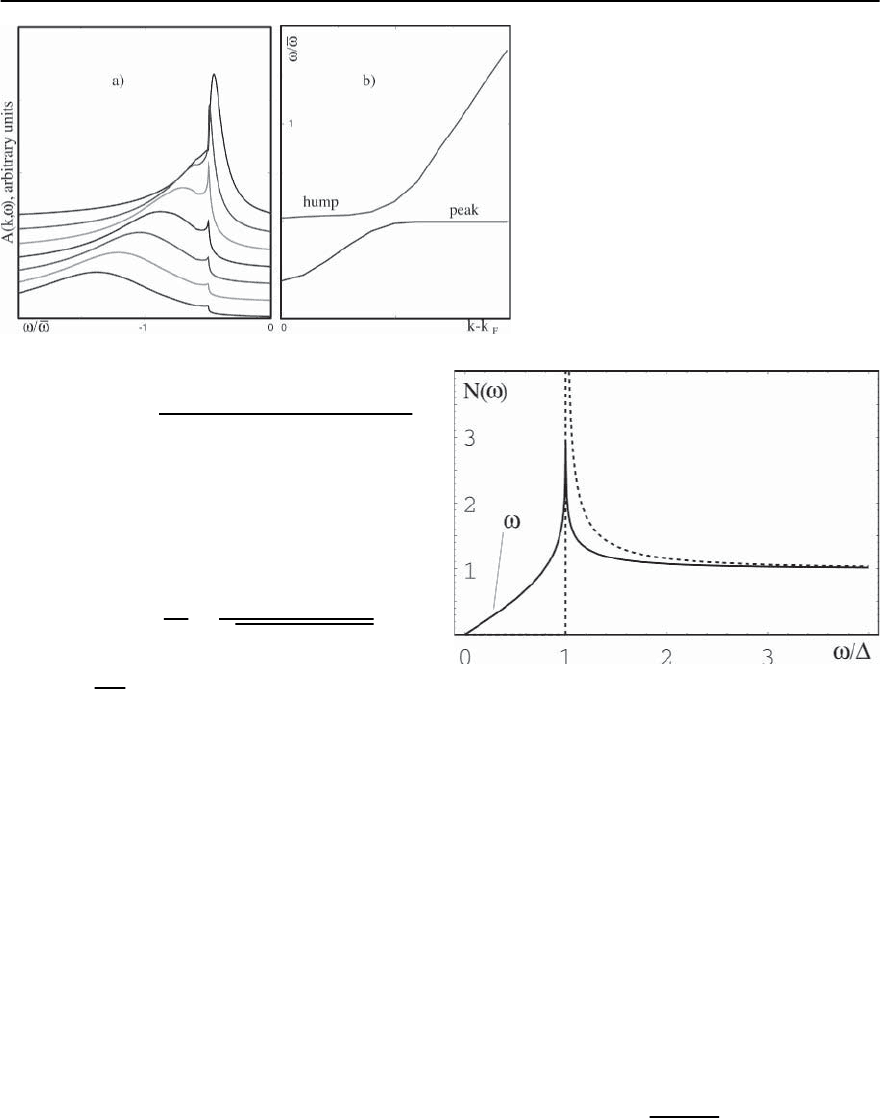
1382 A.V. Chubukov, D. Pines, and J. Schmalian
Fig. 22.18. (a) Frequency dependence of the
spectral function in the superconducting state
for different
k
. The curve at the bottom has a
highest
k
. No coherent quasiparticle peak oc-
curs for energies larger than +
s
.Instead,the
spectral function displays a broad maximum,
similar to that in the normal state. (b)(From
[133])
N(!) ∝ Im
2
0
d
! + £(, !)
(¥
2
(, !)−
(
! + £(, !)
)
2
)
1/2
.
(22.85)
We first consider N(!)inad-wave gas,and then dis-
cuss strong coupling effects. In a d-wave gas, £ =0
and
k
= cos
(
2
)
. Integrating in (22.85) over we
obtain [154,155]
N(!)=N
0
Re
⎡
⎣
!
2
2
0
d
!
2
−
2
cos
2
(2)
⎤
⎦
=
2N
0
K(/!) , for ! >
(!/)K(!/) , for ! <
,
(22.86)
where K(x) is the elliptic integral of first kind.We see
that N(!) ∼ ! for ! and diverges logarithmi-
cally as (1/) ln(8/| − !|)for! ≈ .Atlarger
frequencies, N(!) gradually decreases towards the
frequency independent, normal state value of the
DOS,which we have normalized to unity. The plot of
N(!)inad-wave BCS superconductor is presented
in Fig. 22.19.
For comparison, in an s-wave superconductor, the
DOS vanishes at ! < and diverges as N(!) ∝
(! − )
−1/2
at ! ≥ .Weseethatad-wave super-
conductor is different in that (i) the DOS is finite
down to the smallest frequencies, and (ii) the singu-
larity at! = is weaker (logarithmic).Still,however,
N(!) is singular only at a frequency which equals to
the largest value of the d-wave gap. This illustrates
Fig. 22.19. Density of states of a noninteracting Fermi gas
with a d-wave gap (solid line)andwithans-wave gap
(dashed line).(From [133])
a point made earlier: the angular dependence of the
d-wave gap reduces the strength of the singularity at
! =
max
(), but does not wash it out over a finite
frequency range.
We now turn to strong coupling. We first demon-
strate that the DOS possesses extra peak-dip features,
associated with the singularities in
˜
£(!)and¥ (!)
at ! = §
t
= +
s
.An analytical approach proceeds
as follows [156].Consider first a case when the gap is
totally flat near a hot spot, i.e. ()=.At! = §
t
,
both
˜
£(!)and¥ (!)diverge logarithmically.On sub-
stituting these forms into (22.85),we find that N(!)
has a logarithmic singularity:
N
sing
(!) ∝
log
1
|! − §
t
|
1/2
. (22.87)
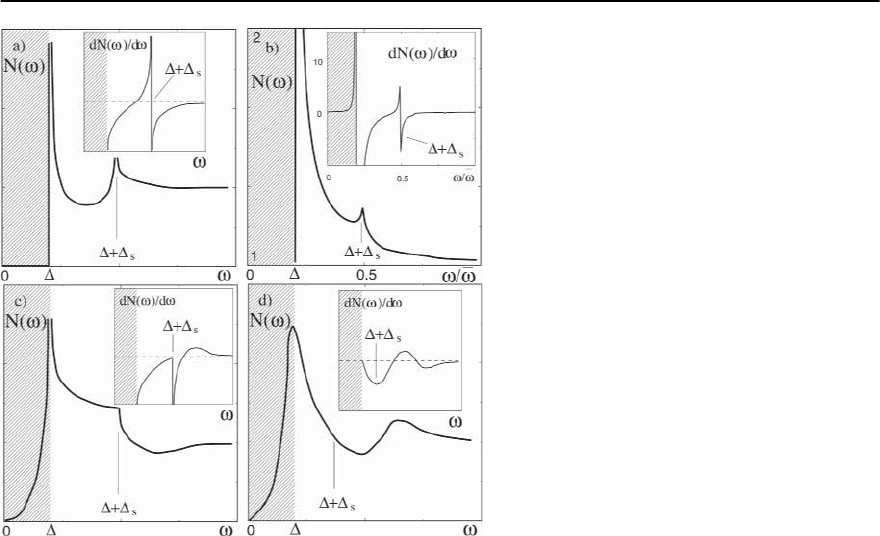
22 A Spin Fluctuation Model for d-Wave Superconductivity 1383
Fig. 22.20. (a) The behavior of the SIN tunneling
conductance (i.e., DOS) in a strongly coupled d-
wave superconductor. Main pictures: N(!), insets:
dN(!)/d!.(a) The schematic behavior of the DOS
for a flat gap. (b) The solution of the Eliashberg-
type equations for a flat gap. The shaded regions
are the ones in which the flat gap approximation
is incorrect as the physics is dominated by nodal
quasiparticles. (c) The schematic behavior of N(!)
for the quadratic variation of the gap near its max-
ima. (d) The expected behavior of the DOS in a real
situation when singularities are softened out by fi-
niteT or impurity scattering. The position of +
s
roughly corresponds to a minimum of dN(!)/d!.
The figure is taken from [133]
This singularity gives rise to a strong divergence
of dN(!)/d! at ! = §
t
, a behavior schematically
shown in Fig. 22.20(a). In part (b) of this figure we
present the result for N(!)obtainedbythesolution
of the Eliashberg-type equations (22.63)–(22.69). A
small but finite temperature was used to smear out
divergences.Werecall that the Eliashberg set does not
include the angular dependence of the gap near hot
spots, and hence the numerical result for the DOS in
Fig. 22.20(b) should be compared with Fig. 22.20(a).
We clearly see that N (!) has a second peak at ! = §
t
.
Thispeak strongly affectsthe frequency derivative of
N(!) which become singular near §
t
.
The relatively small magnitude of the singularity
in N(!) is a consequence of the linearization of the
fermionic dispersion near the Fermi surface. For an
actual
k
chosen to fit ARPES data [129], nonlin-
earities in the fermionic dispersion occur at energies
comparable to §
t
. This is due to the fact that hot
spots are located close to (0, ) and related points at
which the Fermi velocity vanishes.As a consequence,
the momentum integration in the spectral function
should have a less pronounced smearing effect than
found in our calculations, and the frequency depen-
dence of N(!) should more resemble that of A(!)
for momenta where the gap is at maximum.
For a momentum dependent gap (), the behav-
ior of fermions near hot spots is the same as when
the gap is flat, but now §
t
depends on as both
and
s
vary as one moves away from a hot spot. The
variation of is obvious, the variation of
s
is due to
the fact that this frequency scales as
1/2
.Sinceboth
and
s
are maximal at a hot spot, we can model the
momentum dependence by replacing
§
t
→ §
t
− a
˜
2
, (22.88)
where
˜
= −
hs
,anda > 0. The singular pieces
of the self-energy and the pairing vertex then behave
as log(§
t
− ! − a
2
)
−1
.Substitutingthese forms into
(22.85) and using the fact that
˜
£(!)−¥ (!) ≈ const
at ! ≈ §
t
,weobtain
N
sing
(!) ∝ Re
d
log(§
t
− ! − a
2
)
−1
−1/2
.
(22.89)
A straightforward analysis of the integral shows that
now N(!) displays a one-sided non-analyticity at
! = §
t
:
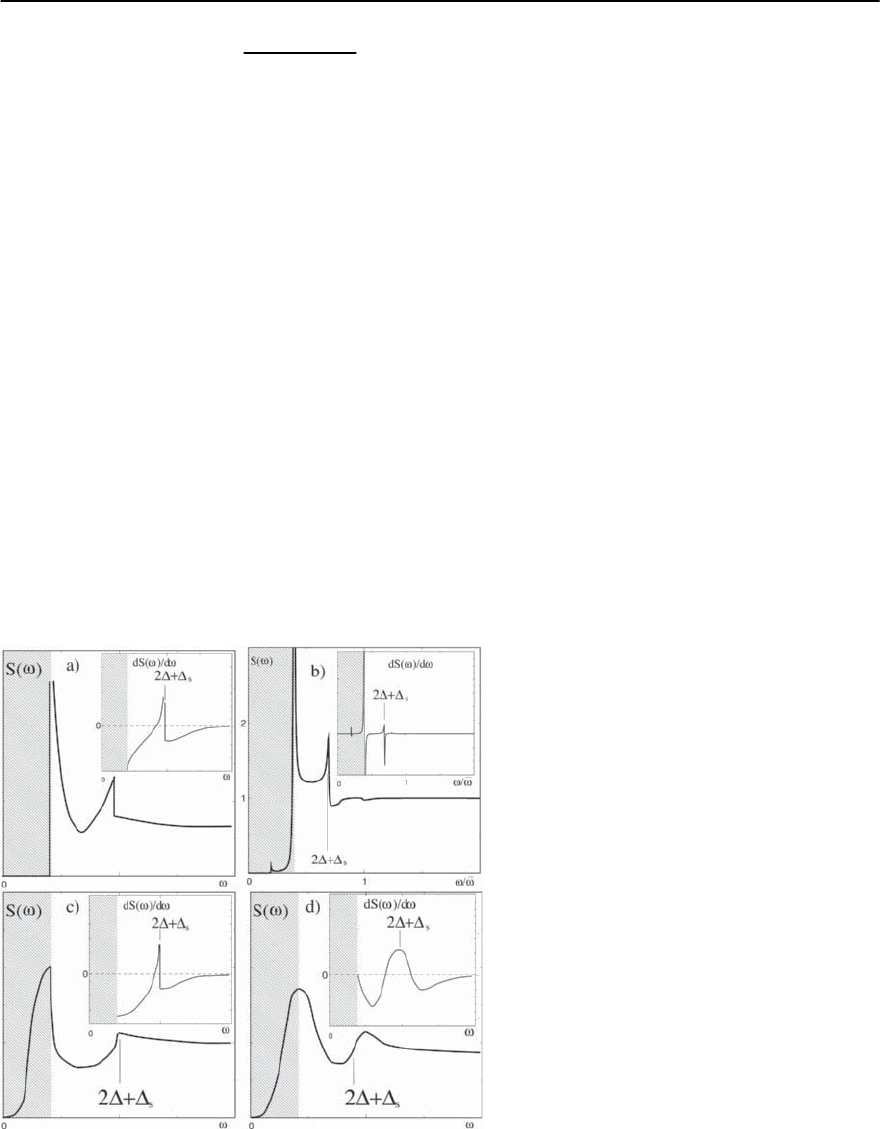
1384 A.V. Chubukov, D. Pines, and J. Schmalian
N
sing
(!)=−BŸ(! − §
t
)
! − §
t
|log(! − §
t
)|
1/2
,
(22.90)
where B > 0, and Ÿ(x) = 1 for x > 0, and
Ÿ(x) = 0 for x < 0. This non-analyticity gives rise
to a cusp in N(!)rightabove§
t
,andone-sided
square root divergence of the frequency derivative
of the DOS. This behavior is shown schematically
in Fig. 22.20(c). Comparing this behavior with that
shown in Fig. 22.20(a) for a flat gap, we observe that
the angular dependence of the gap predominantly
affects the form of N(!)at! ≤ §
t
. At these fre-
quencies,the angular variation of the gap completely
eliminates the singularity in N(!).At the same time,
above §
t
, the angular dependence of the gap softens
thesingularity,but,still,theDOS sharply drops above
§
t
in such a way that the derivative of the DOS di-
verges on approaching §
t
from above. We see again
that in a d-wave superconductor, the singularity in
the DOS is softened by the angular dependence of
the gap, but still persists at a particular frequency
related to the maximum value of the gap. This point
is essential as it enables us to read off the maximum
gap value directly from the experimental data with-
out any “deconvolution” of momentum averages.
For real materials, in which singularities are re-
moved by e.g., impurity scattering, the location of
§
t
is best described as a point where the frequency
derivative of the DOS passes through a minimum
(Fig. 22.20(d)). The singularity in dN(!)/d! at §
t
,
and the dip-hump structure of N(!)at! ≥ §
t
are additional “fingerprints” of the spin-fluctuation
mechanism in the single particle response.
22.5.5 SIS Tunneling
Measurements of the dynamical conductance dI/dV
through a superconductor-insulator-superconductor
(SIS) junction offer another tool to search for the
fingerprints of the spin-fluctuation mechanism. The
conductance through this junction is the derivative
over voltage of the convolutionof the two DOS [152]:
dI/dV ∝ S(!)where
S(!)=N
−2
0
!
0
d§N(! − §) ∂
§
N(§) . (22.91)
Fig. 22.21. (a) The schematic behavior of the SIS
tunneling conductance, S(!), in a strongly coupled
d-wave superconductor.Main pictu res: S(!),insets:
dS(!)/d!.(a) The schematic behavior of S(!)for
aflatgap.(b) The solution of the Eliashberg-type
equations for a flat gap using the DOS from thepre-
vious subsection. The shaded regions are the ones
in which the flat gap approximation is incorrect as
the physics is dominated by nodal quasiparticles.
(c) The schematic behavior of S(!) for a quadratic
variation of the gap near its maxima. (d)Theex-
pected behavior of the SIS conductance in a real
situation when singularities are softened out by fi-
nite T or by impurity scattering. 2 +
s
roughly
corresponds to the maximum of dS(!)/d!.(From
[133])
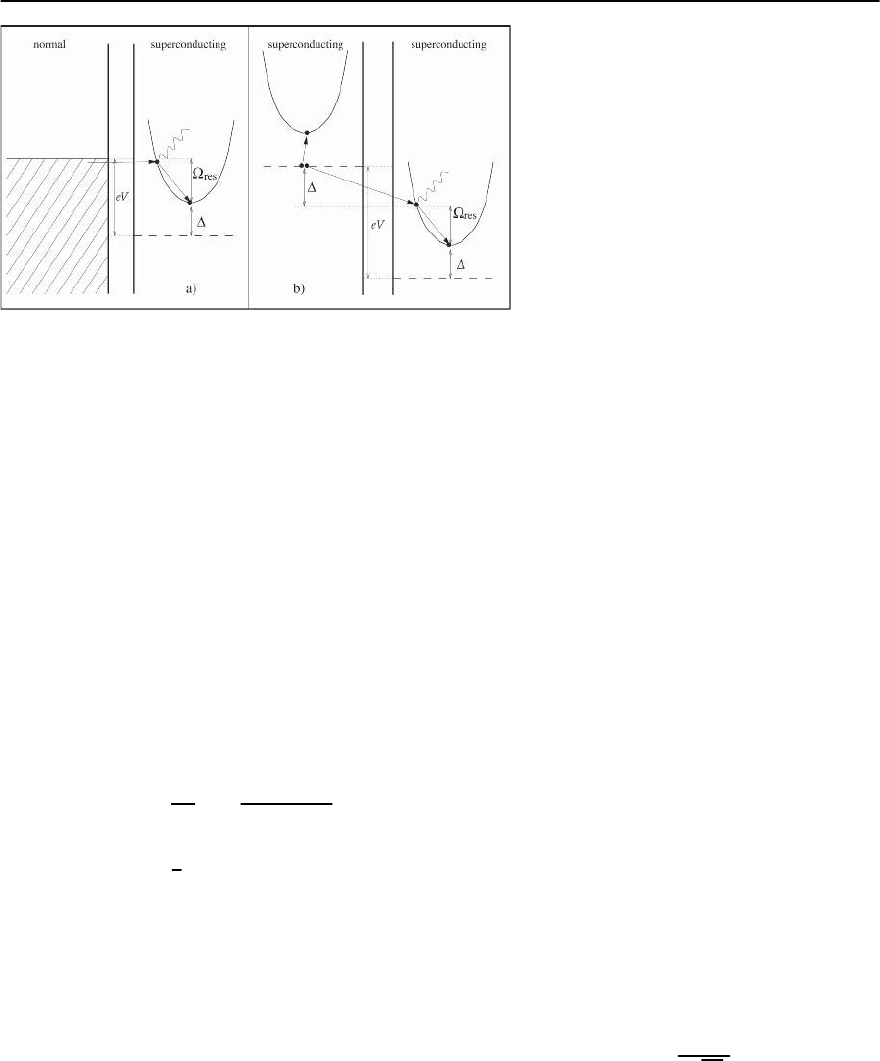
22 A Spin Fluctuation Model for d-Wave Superconductivity 1385
Fig. 22.22. The schematic diagram for the dip features in SIN and SIS tunneling conductances ((a)and(b), respectively).
For SIN tunneling, which measures the fermionic DOS, the electron which tunnels from a normal metal can emit a
propagating magnon if the voltage eV = +
s
. After emitting a magnon, the electron falls to the bottom of the band.
This leads to a sharp reduction of the current and produces a drop in dI/dV . For SIS tunneling, the physics is similar, but
one first has to break an electron pair, which costs energy 2 (taken from [156])
The DOS in a d-wave gas is given in (22.86). Sub-
stituting this form into (22.91) and integrating over
frequency we obtain the result presentedin Fig.22.21.
At small !, S(!) is quadratic in ! [154]. This is an
obvious consequence of the fact that the DOS is lin-
ear in !.At! =2, S(!) undergoes a finite jump.
This jump is related to the fact that near 2,thein-
tegral over the two DOS includes the region around
§ = where both N(§)andN(! − §) are logarith-
mically singular, and ∂
§
N(§)divergesas1/(§ − ).
The singular contribution to S(!)fromthisregion
can be evaluated analytically and yields
S(!)=−
1
2
P
∞
−∞
dx log |x|
x + ! −2
=−
1
2
sign(! −2) . (22.92)
Observe that the amplitude of the jump in the SIS
conductance is a universal number which does not
depend on the value of .At larger frequencies, S(!)
continuously goes down and eventually approaches
avalueofS(! →∞)=1.
Inthecaseofstrongcouplingonefindsagainthat
the quadratic behavior at low frequencies and the
discontinuity at 2 survive at arbitrary coupling. In-
deed, the quadratic behavior at low ! is just a con-
sequence of the linearity of N(!) at low frequencies.
Therefore, just as we did for the density of states we
concentrate on behavior above 2 that is sensitive to
strong coupling effects.
Consider first how the singularity in
˜
£(!)at§
t
affects S(!). From a physical perspective, we would
expect a singularity in S(!)at! = +§
t
=2 +
s
.
Indeed, to get a nonzero SIS conductance, one has to
first break a Cooper pair, which costs an energy of
2. After a pair is broken, one of the electrons be-
comes a quasiparticle in a superconductor and takes
the energy , while the other tunnels. If the tunnel-
ing voltage equals + §
t
, the electron which tunnels
through a barrier has energy §
t
, and can emit a spin
excitation and fall to the bottom of the band (see
Fig. 22.22). This behavior is responsible for the drop
in dI/dV and is schematically shown in Fig. 22.21.
Consider this effect in more detail [133,156].We
first note that ! = + §
t
is special for (22.91) be-
cause both dN(§)/d§ and N(! − §)divergeatthe
same energy, § = §
t
. Substituting the general forms
of N(!)near! = §
t
and ! = ,weobtainafter
simple manipulations that for a flat gap, S(!)hasa
one-sided divergence at ! = §
t
+ =2 +
s
.
S
sing
() ∝
Ÿ(−)
√
−
, (22.93)
where = ! −(§
t
+ ). This obviously causes a di-
vergence of the frequency derivative of S (!)(i.e.of

1386 A.V. Chubukov, D. Pines, and J. Schmalian
d
2
I/dV
2
). This behavior is schematically shown in
Fig. 22.21(a). In Fig. 22.21(b) we present the results
for S(!) obtained by integrating theoretical N(!)
from Fig. 22.20(b). We clearly see that S(!)andits
frequency derivative are singular at ! =2 +
s
,in
agreement with the analytical prediction.
For a quadratic variation of the gap near the max-
ima, calculations similar to those for the SIN tunnel-
ing yield the result that S(!) is continuous through
2 +
s
, but its frequency derivative diverges as
dS(!)
d!
∝ P
0
dx
(x|log x|)
1/2
(
x −
)
∼
Ÿ(−)
| log |||
1/2
. (22.94)
Thesingularityinthederivativeimpliesthatnear
=0
S()=S(0) − C Ÿ(−)
−
|log(−)|
1/2
, (22.95)
where C > 0. This behavior is schematically pre-
sented in Fig. 22.21(d).We again see that the angular
dependence of the gap softens the strength of the
singularity, but the singularity remains confined to a
single frequency ! =2 +
s
.
In real materials, the singularity in S(!)issoft-
ened and transformsinto a dip slightly below 2+
s
,
and a hump at a frequency larger than 2 +
s
.The
frequency 2 +
s
roughly corresponds to a maxi-
mum of the frequency derivative of the SIS conduc-
tance.
22.5.6 Optical Conductivity and Raman Response
Other phenomena sensitive to §
t
are the optical con-
ductivity, (!) and the Raman response, R(!).Both
are proportional to the fully renormalized particle–
hole polarization bubble,but with different signs at-
tributedto the bubblecomposed of anomalous prop-
agators.Specifically, after integrating in the particle–
hole bubble over "
k
,oneobtains
R(!)=Im
d!
dV
2
()¢
r
(, !, !
) , (22.96)
(!)=Re
i
! + iı
d!
d¢
(, !, !
)
,
where V () is a Raman vertex which depends on the
scattering geometry [157], and
¢
r,
(, !, !
)=
˜
£
+
˜
£
−
+ ˛¥
+
¥
−
+ D
+
D
−
D
+
D
−
(D
+
+ D
−
)
. (22.97)
Here ˛ = −1 for ¢
r
,and˛ = 1 for ¢
.Also,
˜
£
±
=
˜
£
(
!
±
)
and ¥
±
= ¥
(
!
±
)
,where!
±
= !
±!/2.We
also introduced D
±
=(¥
2
±
−
˜
£
2
±
)
1/2
.Notethat
˜
£ and
¥ depend on ! and .
In a superconducting gas,the optical conductivity
vanishes identically for any nonzero frequency due
to the absence of a physical scattering between quasi-
particles in a gas. The presence of a superconducting
condensate,however,gives rise to a ı functionalterm
in at ! =0:(!)=ı(!)
dd!
¢
(, 0, !
).
This behavior is typical for any BCS superconduc-
tor[158].Thebehavior of (!) fora d-wave gaswith
additional impurities, causing inelastic scattering,is
more complex and has been discussed in [159].
The form of the Raman intensity depends on
the scattering geometry. For the scattering in the
B
1g
channel, the Raman vertex has the same an-
gular dependence as the d-wave gap, i.e. V() ∝
cos
(
2
)
[157, 160]. Straightforward computations
then show that at low frequencies, R(!) ∝ !
3
[160].
For a constant V(), we would have R(!) ∝ !.
Near ! =2,theB
1g
Raman intensity is singular.
For this frequency, both D
+
and D
−
vanish at !
=0
and =0.ThiscausestheintegralforR(!)tobe
divergent. The singular contribution to R(!)canbe
obtained analytically by expanding in the integrand
to leading order in !
and in . Using the spectral
representation, we then obtain, for ! =2 + ı [157]
R(!)=
0
d§
d
˜
1
§ + a
˜
2
ı − § + a
˜
2
×
1
(
§ + a
˜
2
+
ı − § + a
˜
2
)
, (22.98)
where, as before,
˜
= −
hs
For a flat band (a =0),
R(!) ∝ Re[(! −2)
−1/2
]. For a = 0,i.e.fora
quadratic variation of the gap near its maximum,the
2D integration in (22.98) is elementary, and yields
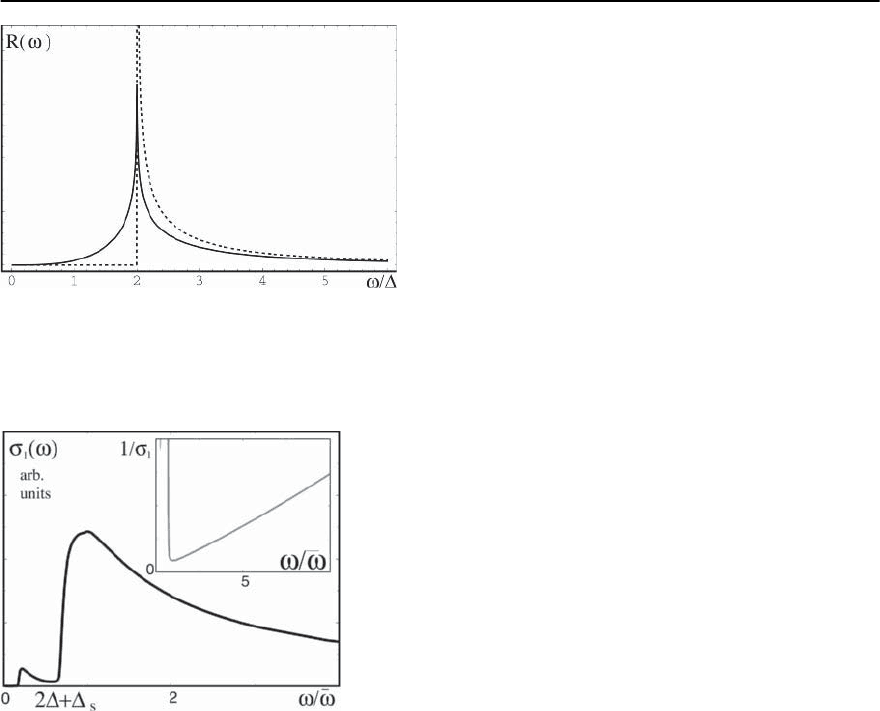
22 A Spin Fluctuation Model for d-Wave Superconductivity 1387
Fig. 22.23. The behavior of the Raman response in a BCS
superconductor with a flat gap (dashed line), and for a
quadratic variation of the gap near its maximum (solid
line)
Fig. 22.24. The real part of the optical conductivity
1
(!)at
the lowestT obtained using the self energy and the pairing
vertex from the solution of the Eliashberg equations for
= 1. The onset of the optical response is ! =2 +
s
.
The contributions from nodal regions (not included in
calculations) yield a nonzero conductivity at all !. In-
set: the behavior of the inverse conductivity vs frequency.
(From [161])
R(!) ∝ log |! −2|. At larger frequencies R(!)
gradually decreases.
The behavior of R(!)inad-wave gas is shown
in Fig. 22.23. Observe that due to the interplay of
numerical factors, the logarithmic singularity shows
up only in the near vicinityof 2, while at somewhat
larger !,the angular dependence of the gap becomes
irrelevant, and R(!)behavesas(! −2)
1/2
,i.e.the
same as for a flat gap [155].
We now consider strong coupling effects. A
nonzero fermionic self-energy mostly affects the op-
tical conductivity for the simple reason that it be-
comes finite in the presence of spin scattering which
can relax fermionic momenta. For a momentum-
independentgap,a finite conductivity emergesabove
a sharp threshold.This threshold stems from the fact
that at least one of the two fermions in the conduc-
tivity bubble should have a finite
˜
£
,i.e.itsenergy
should be larger than §
t
.Anotherfermionshouldbe
able to propagate,i.e.its energy should be larger than
. The combination of the two requirements yields
the threshold for (! > 0) at 2 +§
t
,i.e.atthesame
frequency where the SIS tunneling conductance is
singular. One can easily demonstrate that for a flat
gap,the conductivity behaves above the threshold as
1/2
/ log
2
,where = ! −( + §
t
)=! −(2 +
s
).
This singularity obviously causes a divergence of the
first derivative of the conductivity at =+0.
In Fig. 22.24 we show the result for the conductiv-
ity obtained by solving the set of coupled Eliashberg-
type equations, (22.63)–(22.69)[161,162].We see the
expected singularity at 2 +
s
. The insert shows the
behavior of theinverseconductivity 1/ (!) Observe
that 1/ (!)islinearin! over a rather wide fre-
quency range [162].
For a d-wave gap = (), the conductivity is
finite for all frequencies simply because the angular
integration in (22.97) involves the region near the
nodes, where
˜
£
is nonzero down to the lowest fre-
quencies.Still,the conductivity is singular at §
t
+ as
we now demonstrate.Indeed,as we already discussed,
at deviations from =
hs
, where the gap is at maxi-
mum,both and
s
decrease,hence §
t
()=§
t
−a
˜
2
,
where
˜
= −
hs
and a > 0. The singular pieces in
˜
£(!)and¥ (!)thenbehaveas|log(§
t
− ! − a
2
)|.
Substituting these forms into the particle–hole bub-
ble and integrating over , we find that the con-
ductivity and its first derivative are continuous at
! =2 +
s
, but the second derivative of the con-
ductivity diverges as d
2
/d!
2
∝ 1/(||log
2
). We
see that the singularity is weakened by the angular
dependence of the gap, but is still located exactly at
§
t
+ =2 +
s
.
The same reasoning can be applied to a region
near 4.Thesingularityat4 is also weakened by
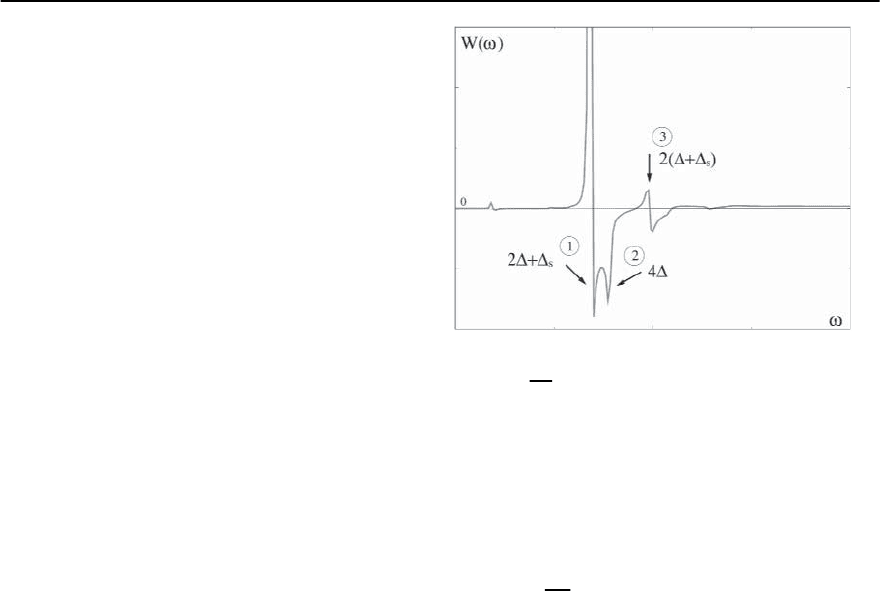
1388 A.V. Chubukov, D. Pines, and J. Schmalian
the angular dependence of the gap, but is not shifted
and still should show up in the second derivative of
the conductivity.
For the Raman intensity, strong coupling effects
are less relevant. First, one can prove along the same
lines as in previous subsections that the cubic behav-
ior at low frequencies for B
1g
scattering (and the lin-
ear behavior for angular independent vertices), and
the logarithmic singularity at 2, are general prop-
erties of a d-wave superconductor, whichsurvive for
all couplings. Thus,analogous to the density of states
andthe SIS-tunneling spectrum,theRaman response
below 2 is not sensitive to strong coupling effects.
Second, near !
0
+ , singular contributions which
come from
˜
£
+
˜
£
−
and ¥
+
¥
−
terms in ¢
r
in (22.97)
cancel each other. As a result, for a flat gap, only the
second derivative of R(!)divergesat + §
t
.For
a quadratic variation of a gap near its maximum,
the singularity is even weaker and shows up only in
the third derivative of R(!). Obviously,this is a very
weak effect, and its experimental determination is
difficult.
We now argue that measurements of the optical
conductivity allow one not only to verify the mag-
netic scenario, but also to determine both
s
and
independently in the same experiment. In the mag-
netic scenario, the fermionic self-energy is singular
at two frequencies: at §
t
= +
s
,whichistheon-
set frequency for spin-fluctuation scattering near hot
spots, and at ! =3,where fermionic damping near
hot spots first emerges due to a direct four-fermion
interaction.Since in the spin-fluctuationmechanism
both singularities are due to the same underlying
interaction, their relative intensity can be obtained
within the model.
In general,the singularity at 3 is much weaker at
strong coupling,andcan be detected only in the anal-
ysis of the derivatives of the fermionic self-energy.
We recall that the singularity in
˜
£(!)at§
t
gives rise
to singularity in the conductivity at + §
t
,whilethe
3 singularity in
˜
£(!) obviouslycauses a singularity
in conductivity at ! =4.Inaddition,weexpecta
singularity in (!)at2§
t
,asatthisfrequencyboth
fermions in the bubble have a singular
˜
£(§
t
).
For superconductorswithpairingduetoelectron–
phonon interaction the fine structure of the op-
Fig. 22.25. The calculated frequency dependence of
W(!)=
d
2
d
2
!
[!Re[1/ (!)]] at T → 0. This quantity is
a sensitive measure of the fine structure in the optical re-
sponse.The locations of the extrema are: (1) 2+
s
,(2)4,
(3) 2 +2
s
. Observe that the maximum shifts to a lower
temperature, but the minimum remains at 2 +
s
.(From
[161])
tical conductivity has been analyzed by study-
ing the second derivative of conductivity via
W(!)=
d
2
d
2
!
(!Re
−1
(!)) which is proportional
to ˛
2
(!)F(!)where˛(!) is an effective electron–
phonon coupling, and F(!) is a phonon DOS [117].
In Fig. 22.25 we present the result of the strong cou-
pling calculations of W(!) [161]. There is a sharp
maximum in W(!)near2 +
s
, which is followed
by a deep minimum.This form is consistent with our
analytical observation that for a flat gap (which we
used in our numerical analysis), the first derivative
of conductivity diverges at ! =2 +
s
.Atafinite
T (a necessary attribute of a numerical solution), the
singularity is smoothed,and the divergence is trans-
formed into a maximum. Accordingly, the second
derivative of the conductivity should have a maxi-
mum and a minimum near 2 +
s
.Thenumerical
analysis shows that the maximum shifts to lower fre-
quencies with increasing T,but the minimum moves
very little from 2 +
s
, and is therefore a good mea-
sure of a magnetic “fingerprint”.
Second,we notefrom Fig.22.25 that in addition to
the maximum and the minimum near 2 +
s
,W(!)
has extra extrema at 4 and 2§
t
=2 +2
s
.These
are precisely the extra features that we expect: they

22 A Spin Fluctuation Model for d-Wave Superconductivity 1389
are a primary effect due to a singularity in
˜
£(!)at
! =3 and a secondary effect due to a singular-
ity in
˜
£(!)at! = §
t
. The experimental discovery
of these features will be a further argument in favor
of spin-mediated pairing and the applicability of the
spin–fermion model.
22.6 Comparison with the Experiments
on Cuprates
In this section we compare the theoretical results for
the spin–fermion model of the nearly antiferromag-
netic Fermi liquid with the experimental data for op-
timally doped members of the Bi
2
Sr
2
CaCu
2
O
8
and
YBa
2
Cu
3
O
7−y
families of cuprate superconductors.
We make the assumption that at this doping level
the normal state behavior of Bi
2
Sr
2
CaCu
2
O
8
will re-
semble closely that of YBa
2
Cu
3
O
7−y
.Thisenablesus
to take the two input parameters of the model from
fits to NMR in the latter material. We then can com-
pare theory and experiment in the normal state and
as T → 0 in the superconducting state. Finally, we
discuss the general phase diagram of the cuprates
and the pseudogap physics of these materials.
22.6.1 Parameters of the Model
The two input parameters of the theory are the
coupling constant and the overall energy scale
¯! =4
2
!
sf
. Alternatively, we can re-express as
=3v
F
−1
/(16!
sf
) and use v
F
−1
and !
sf
as inputs.
The values of !
sf
and can be extracted from the
NMR measurements of the longitudinal and trans-
verse spin-lattice relaxation rates, and from neutron
scattering data, which measure S(q, !) ∝ !/((1 +
(q − Q)
2
2
)
2
+(!/!
sf
)
2
). We will primarily rely on
NMR data for near optimally doped YBa
2
Cu
3
O
6+ı
.
TheNMRanalysis[163,164]yields amoderately tem-
perature dependent !
sf
and which take the values
!
sf
∼ 15 − 20meV and ∼ 2a in the vicinity of
T
cr
, which for slightly overdoped materials will be
close to T
c
. The neutron data from inelastic scatter-
ing (INS) experiments on the normal state are more
difficult to analyze because of the background which
increases the measured width of the neutron peak
and because of the possible influence of weak in-
trinsic inhomogeneities on a global probe such as
INS. The data show [165] that the dynamical struc-
ture factor in the normal state is indeed peaked at
q = Q =(/a, /a), and that the width of the peak
increases with frequency and at ! = 50meV reaches
1.5ofitsvalueat! = 0. A straightforward fit to the
theory yields !
sf
∼ 35–40 meV and a weakly tem-
perature dependent ∼ a which are, as expected,
larger than the !
sf
and smaller than the values ex-
tracted from NMR. We will be using !
sf
∼ 20 meV
and =2a for further estimates.
The value of the Fermi velocity can be obtained
from the photoemission data on Bi
2
Sr
2
CaCu
2
O
8
at
high frequencies, where the self-energy corrections
to the fermionic dispersion become relatively minor.
We note that because of problems related to the sur-
facereconstructioninYBa
2
Cu
3
O
6+ı
thevast majority
of high quality angular resolvedphotoemissionspec-
troscopy (ARPES) experiments are performed on
Bi
2
Sr
2
CaCu
2
O
8
, the material where there are much
less reliable NMR experiments in part because of
superstructure induced line broadening. The three
groups that report MDC (momentum distribution
curve) data for Bi
2
Sr
2
CaCu
2
O
8
and momenta along
the zone diagonal [137,166, 167] all agree that the
value of the bare Fermi velocity along the diagonal
(determined at higher energies where mass renor-
malization is assumed to be small) is rather high:
2.5−3eVÅ,or0.7−0.8eVa where a 3.8Å is
the Cu − Cu distance. We can use the t − t
tight
binding model for the electronic dispersion to re-
late this velocity with that at hot spots. Using the
experimental facts that the Fermi surface is located
at k ≈ (0.4/a, 0.4/a) for momenta along the zone
diagonal and at k ≈ (/a, 0.2/a) for k
x
along the
zone boundary,we find t ∼ 0.2−0.25eV,t
≈ −0.35t
and ≈ −1.1t.These numbers agree with those used
in other numerical studies [168]. The hot spots are
located at k
hs
=(0.16, 0.84) and symmetry re-
lated points, and the velocity at a hot spot is then
approximately half of that along zone diagonal. This
yields v
F
≈ 0.35 − 0.4eVa.
Combining the results for v
F
, and !
sf
,weobtain
∼ 1.5 − 2. This in turn yields ¯! ∼ 0.2−0.3eV.
As an independent check of the internal consistency

1390 A.V. Chubukov, D. Pines, and J. Schmalian
of these estimates, we compare theoretical and ex-
perimental values of the resonance spin frequency
s
. As we said at the end of Sect. 22.4,
s
0.2 ¯!
for = 2. Substituting the value of ¯!,weobtain
s
close to the experimental value of 40meV. A smaller
!
sf
= 15 meV would require a slightly larger ,but
variations of this magnitude are certainly beyondthe
quantitative accuracy of our theory.
Away from hot spots, the effective coupling de-
creases as (k)=/(1 + (ık)
2
)
1/2
where ık is
the momentum deviation from a hot spot along the
Fermi surface. The largest ık is for k vectors along
the zone diagonals. At optimal doping, ARPES data
yield ık
max
∼ 0.2/a ≈ 0.6/a [169]. We see that
is reduced by at most 1.7asonemovesfromhot
spots to the zone diagonal.A prediction of the model
is that !
sf
(k) increases at deviations from hot spots.
This increase,however,should be at least partly com-
pensated by the fact that !
sf
∝ sin
0
,where
0
is
the angle between Fermi velocities at k and k + Q,
with
0
2
in the vicinity of hot spots.
0
tends
to as k approaches the zone diagonal, and this
reduces !
sf
. In view of this competing effect which
we cannot fully control, we believe that the effective
!
sf
(k) can best be obtained from the fit to the pho-
toemission data, particularly from the MDC mea-
surements of the electronic dispersion ! + £
(!)=
k
. In Fig. 22.26 we compare our (1 + ∂£
(!)/∂!)
with the measured variation of the effective veloc-
ity v
F
(!) of the electronic dispersion along zone di-
agonal [137]. We see that the theoretical dispersion
has a bump (a “soft kink”) at ! ∼ 3!
sf
(k
diag
). The
experimental curves look quite similar and show a
“kink” at ∼ 70 − 80meV [137,166,167]. This yields
!
sf
(k
diag
) ∼ 25meV, a value only slightly larger than
that near hot spots.
Note in passing that although ık does not
vary much when k moves along the Fermi surface,
the fact that the Fermi velocity is fairly large im-
plies that along the zone diagonal,
k
F
+Q
is roughly
√
2v
F
0.2/a ≈ 0.8eV, i.e. it is comparable to the
bandwidth. This implies that the Fermi-surface is
very different from the near-perfect square that one
would obtain for only nearest neighbor hopping.Fur-
thermore, the fact that the Fermi velocity is large
implies the physics at energies up to few hundred
meV is confined to the near vicinity of the Fermi
surface, when one can safely expand
k
to linear or-
der in k − k
F
. Finally, van-Hove singularities (which
we neglected) do play some role [170, 171] but as
(
0,/a
)
≈ 0.34t ∼ 85meV !
sf
,weexpectthat
the van-Hove singularity softens due to fermionic
incoherence and should not substantially affect the
physics. The value of
(
0,/a
)
might however be af-
fected by an additional bilayer splitting which moves
one of the bands closer to k =
(
0, /a
)
.
Finally, in the analysis of the spin–fermion model
we have neglected the temperature dependence of
the correlation length, and thus of !
sf
. Fits to NMR
experiments on the near optimally doped member
of the YBa
2
Cu
3
O
6+ı
family show that at T
cr
T
c
both !
sf
and display mean field behavior with
−2
−2
0
(
1+T/T
0
)
and !
sf
2
70meV almost
independent on T.
From a theoretical perspective, the leading tem-
perature dependence of arises from an interac-
tion between spin-fluctuations and near the criti-
cal point in two dimensions has the form
−2
(T)=
Fig. 22.26. (a) The theoretical result for the
effective velocity of the quasiparticles v
∗
F
=
v
F
/(1 + ∂£
(!)/∂!). For definiteness we used
!
sf
=20meV, =1.7andbarevelocity
v
F
= 3 eVA along the diagonal. (b)Experi-
mental result for the effective velocity,extracted
from the MDC dispersion [137] along the zone
diagonal. Observe the bump in the frequency
dependence of the velocity at 70 − 80 meV in
the data and at about 3 − 4!
sf
in the theory
